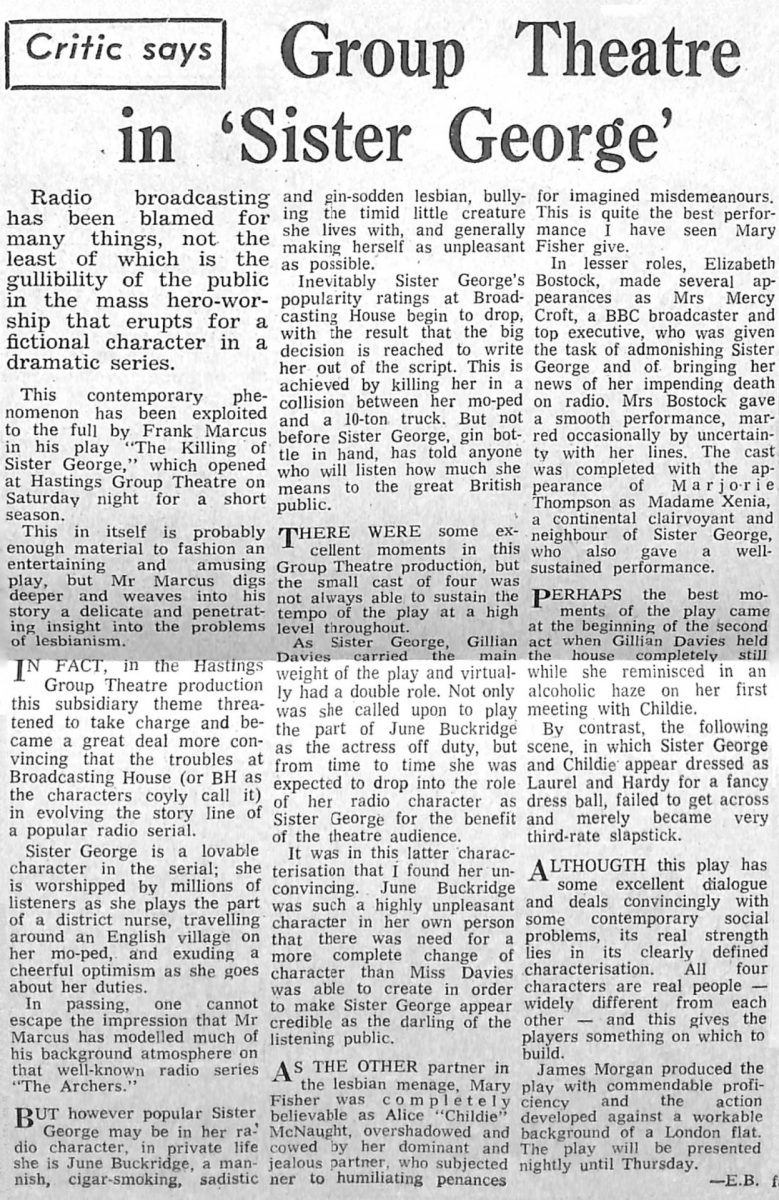Critic says
Group Theatre in ‘Sister George’
Radio broadcasting has been blamed for many things, not. the least of which is the gullibility of the public in the mass hero-worship that erupts for a fictional character in a dramatic series.
This contemporary phenomenon has been exploited to the full by Frank Marcus in his play “The Killing of Sister George,” which opened at Hastings Group Theatre on Saturday night for a short season.
This in itself is probably enough material to fashion an entertaining and amusing play, but Mr Marcus digs deeper and weaves into his story a delicate and penetrating insight into the problems of lesbianism.
IN FACT, in the Hastings Group Theatre production this subsidiary theme threatened to take charge and became a great deal more convincing that the troubles at Broadcasting House (or BH as the characters coyly call it) in evolving the story line of a popular radio serial.
Sister George is a lovable character in the serial; she is worshipped by millions of listeners as she plays the part of a district nurse, travelling around an English village on her mo-ped, and exuding a cheerful optimism as she goes about her duties.
In passing, one cannot escape the impression that Mr Marcus has modelled much of his background atmosphere on that well-known radio series “The Archers.”
BUT however popular Sister George may be in her radio character, in private life she is June Buckridge, a mannish, cigar-smoking, sadistic and gin-sodden lesbian, bullying the timid little creature she lives with, and generally making herself as unpleasant as possible.
Inevitably Sister George’s popularity ratings at Broadcasting House begin to drop, with the result that the big decision is reached to write her out of the script. This is achieved by killing her in a collision between her mo-ped and a 10-ton truck. But not before Sister George, gin bottle in hand, has told anyone who will listen how much she means to the great British public.
THERE WERE some excellent moments in this Group Theatre production, but the small cast of four was not always able to sustain the tempo of the play at a high level throughout.
As Sister George, Gillian Davies carried the main weight of the play and virtually had a double role. Not only was she called upon to play the part of June Buckridge as the actress off duty, but from time to time she was expected to drop into the role of her radio character as Sister George for the benefit of the theatre audience.
It was in this latter characterisation that I found her unconvincing. June Buckridge was such a highly unpleasant character in her own person that there was need for a more complete change of character than Miss Davies was able to create in order to make Sister George appear credible as the darling of the listening public.
AS THE OTHER partner in the lesbian menage, Mary Fisher was completely believable as Alice “Childie” McNaught, overshadowed and cowed by her dominant and jealous partner. who subjected her to humiliating penances for imagined misdemeanours. This is quite the best performance I have seen Mary Fisher give.
In lesser roles, Elizabeth Bostock, made several appearances as Mrs Mercy Croft, a BBC broadcaster and top executive, who was given the task of admonishing Sister George and of bringing her news of her impending death on radio. Mrs Bostock gave a smooth performance, marred occasionally by uncertainty with her lines. The cast was completed with the appearance of Marjorie Thompson as Madame Xenia, a continental clairvoyant and neighbour of Sister George, who also gave a well-sustained performance.
PERHAPS the best moments of the play came at the beginning of the second act when Gillian Davies held the house completely still while she reminisced in an alcoholic haze on her first meeting with Childie.
By contrast, the following scene, in which Sister George and Childie appear dressed as Laurel and Hardy for a fancy dress ball, failed to get across and merely became very third-rate slapstick.
ALTHOUGH this play has some excellent dialogue and deals convincingly with some contemporary social problems, its real strength lies in its clearly defined characterisation. All four characters are real people – widely different from each other – and this gives the players something on which to build.
James Morgan produced the play with commendable proficiency and the action developed against a workable background of a London flat. The play will be presented nightly until Thursday.












Do you know something about this record?
Please note we cannot verify the accuracy of any information posted by the community.